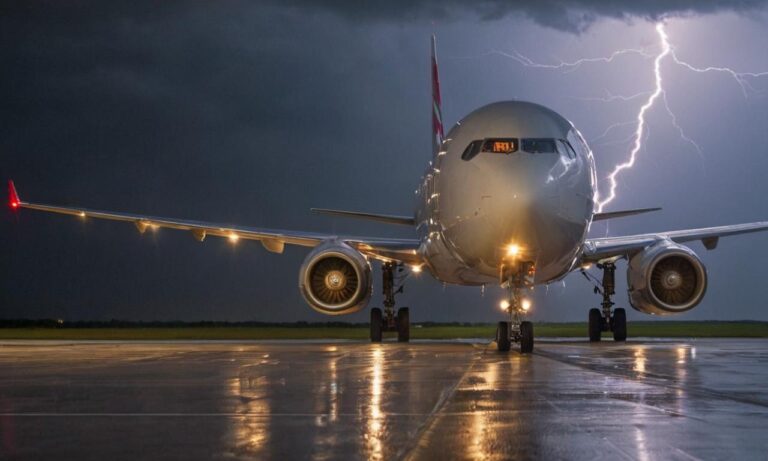When lightning and aircraft intersect, it sparks a fascinating interplay of science, technology, and safety measures. Understanding the dynamics of this encounter is crucial for both passengers and aviation professionals alike.
The Physics Behind Lightning and Aircraft
Lightning, a natural electrical discharge, occurs when there is an imbalance between positive and negative charges in the atmosphere. When an aircraft moves through a region with varying charge levels, it can trigger a lightning strike. Contrary to common perception, planes are not insulated from lightning; instead, they are designed to safely manage the energy from a lightning bolt.
Protective Measures in Aircraft Design
Modern aircraft are equipped with a system known as the lightning protection system (LPS), designed to safeguard the plane and its occupants during a lightning strike. The exterior of the aircraft is often made of conductive materials, allowing lightning to flow around the surface harmlessly. Additionally, specific components, such as fuel tanks and critical electronics, are shielded to prevent damage.
Consequences of a Lightning Strike
While lightning strikes are relatively common occurrences for aircraft, they rarely lead to catastrophic consequences. The energy from the lightning is typically dispersed along the aircraft’s surface, with minimal impact on the structural integrity or functionality of the plane. Passengers may not even be aware that a lightning strike has occurred, as the aircraft systems continue to operate seamlessly.
One area of concern during a lightning strike is the potential impact on communication and navigation systems. However, rigorous testing and design standards ensure that these critical systems remain robust in the face of electrical disturbances. Pilots are trained to follow specific procedures in the event of a lightning strike, and redundant systems are in place to guarantee continued safe operation.
Emergency Scenarios and Pilot Training
While lightning strikes are generally not emergencies, pilots are trained to handle a range of scenarios. Lightning can temporarily affect a plane’s systems, leading to precautionary measures such as rerouting or additional checks. These procedures are in place to ensure the safety of all on board and to prevent any potential complications that may arise from the electrical discharge.
Conclusion
Encounters between lightning and aircraft showcase the meticulous engineering and safety protocols embedded in modern aviation. The design and technology implemented in aircraft, coupled with pilot training, mitigate the risks associated with lightning strikes. Understanding these dynamics provides reassurance to passengers and underscores the resilience of aviation systems in the face of nature’s electrical displays.
Frequently Asked Questions
As curiosity surrounds the interaction between lightning and aircraft, here are answers to some common questions:
How Common Are Lightning Strikes on Planes?
Lightning strikes on planes are relatively common, with commercial aircraft experiencing them regularly. However, due to robust safety measures, these incidents rarely result in significant issues.
Do Passengers Feel or See Lightning Strikes?
In most cases, passengers do not feel or see lightning strikes. The energy from the strike is dispersed across the aircraft’s surface, and the systems continue to operate normally. Passengers may remain unaware of the event.
What Precautions are Taken for Communication Systems?
The communication and navigation systems on aircraft are rigorously tested and designed to withstand the impact of lightning strikes. Pilots follow specific procedures to ensure the continued functionality of these critical systems.
Are Emergency Landings Common After Lightning Strikes?
Emergency landings due to lightning strikes are extremely rare. Pilots are trained to handle various scenarios, and the design of the aircraft, along with redundant systems, minimizes the likelihood of such drastic measures being necessary.
Advancements in Lightning Detection
Continual advancements in technology have led to the development of sophisticated lightning detection systems for aircraft. These systems provide real-time data to pilots, enabling them to make informed decisions about navigation and potential rerouting during adverse weather conditions.
| System | Functionality |
|---|---|
| Lightning Detection Sensors | Identify and track lightning activity in the vicinity of the aircraft. |
| Automated Rerouting Systems | Offer alternative flight paths to avoid areas with intense lightning activity. |
Training Simulators for Lightning Scenarios
Pilots undergo extensive training using simulators that replicate lightning scenarios. These simulations help them practice emergency procedures, ensuring a quick and effective response in the rare event of a lightning-related issue.
Simulator Features:
- Realistic Lightning Strike Visuals
- System Malfunction Scenarios
- Interactive Emergency Response Training






